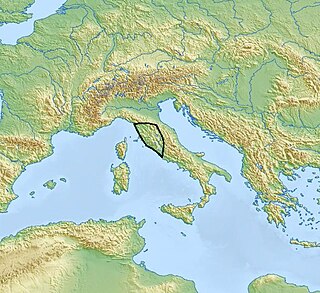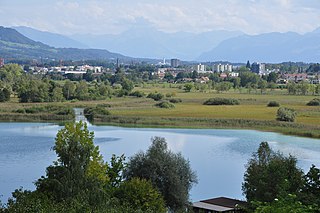Gallery
- Fiavé 6
- Museum display
- Gold spiral ring
- Axe
- Bronze pins and spirals, welded together by a fire
- Remains of a pile dwelling
- Plow
| Geographical range | North Italy |
|---|---|
| Period | Bronze Age |
| Dates | c. 1800-1300 BC |
| Preceded by | Polada culture |
| Followed by | Proto-Villanovan culture, Luco culture |
The faciesof the pile dwellings and of the dammed settlements [1] (Italian: facies delle palafitte e degli abitati arginati) is a cultural aspect of the Middle to Late Bronze Age (c. 1800 to 1300 BC) that developed between eastern Lombardy, Trentino and western Veneto. It was followed in the Final Bronze Age by the Proto-Villanovan culture and by the Luco culture.
The continuity with the previous Polada culture of the Early Bronze Age seems to be unbroken. The villages, as in the previous phase, are on stilts and they were concentrated in the area of the Lake of Garda. In the plains appeared instead villages with levees and ditches.
The bronze metallurgy (weapons, work tools, etc.) was well developed among these populations. As for the burial customs both cremation and inhumation were praticted. Sometimes the two rites coexisted in the same necropolis, as at "Olmo di Nogara".
Archaeological evidence suggests that the society was probably dominated by a warrior elite. [2]
The Apennine culture is a technology complex in central and southern Italy from the Italian Middle Bronze Age. In the mid-20th century the Apennine was divided into Proto-, Early, Middle and Late sub- phases, but now archaeologists prefer to consider as "Apennine" only the ornamental pottery style of the later phase of Middle Bronze Age (BM3). This phase is preceded by the Grotta Nuova facies and by the Protoapennine B facies and succeeded by the Subapennine facies of 13th-century. Apennine pottery is a burnished ware incised with spirals, meanders and geometrical zones, filled with dots or transverse dashes. It has been found on Ischia island in association with LHII and LHIII pottery and on Lipari in association with LHIIIA pottery, which associations date it to the Late Bronze Age as it is defined in Greece and the Aegean.

The Italic peoples were an ethnolinguistic group identified by their use of Italic languages, a branch of the Indo-European language family.
Below are notable events in archaeology that occurred in 1942.

Terramare, terramara, or terremare is a technology complex mainly of the central Po valley, in Emilia, Northern Italy, dating to the Middle and Late Bronze Age c. 1700–1150 BC. It takes its name from the "black earth" residue of settlement mounds. Terramare is from terra marna, "marl-earth", where marl is a lacustrine deposit. It may be any color but in agricultural lands it is most typically black, giving rise to the "black earth" identification of it. The population of the terramare sites is called the terramaricoli. The sites were excavated exhaustively in 1860–1910.

The prehistory of Italy began in the Paleolithic period, when species of Homo colonized the Italian territory for the first time, and ended in the Iron Age, when the first written records appeared in Italy.
The Polada culture is the name for a culture of the ancient Bronze Age which spread primarily in the territory of modern-day Lombardy, Veneto and Trentino, characterized by settlements on pile-dwellings.

Prehistoric pile dwellings around the Alps are a series of prehistoric pile dwelling settlements in and around the Alps built from about 5000 to 500 BC on the edges of lakes, rivers or wetlands. In 2011, 111 sites located variously in Switzerland (56), Italy (19), Germany (18), France (11), Austria (5) and Slovenia (2) were added to the UNESCO World Heritage Site list. In Slovenia, these were the first World Heritage Sites to be listed for their cultural value.
Anna Maria Bietti Sestieri was an Italian contemporary archaeologist based at the Università del Salento whose research focused on Italian prehistory.

The Rinaldone culture was an Eneolithic culture that spread between the 4th and the 3rd millennium BC in northern and central Lazio, in southern Tuscany and, to a lesser extent, also in Marche and Umbria. It takes its name from the town of Rinaldone, near Montefiascone in the province of Viterbo, northern Lazio.

Kleiner Hafner is one of the 111 serial sites of the UNESCO World Heritage Site Prehistoric pile dwellings around the Alps, of which are 56 located in Switzerland.

Prehistoric pile dwellings around Lake Zurich comprises 11 – or 10% of all European pile dwelling sites – of a total of 56 prehistoric pile dwellings around the Alps in Switzerland, that are located around Lake Zurich in the cantons of Schwyz, St. Gallen and Zürich.

Freienbach–Hurden Rosshorn is one of the 111 serial sites of the UNESCO World Heritage Site Prehistoric pile dwellings around the Alps, of which are 56 located in Switzerland.

Rapperswil-Jona/Hombrechtikon–Feldbach or commonly Seegubel is one of the 111 serial sites of the UNESCO World Heritage Site Prehistoric pile dwellings around the Alps, of which are 56 located in Switzerland.

Rapperswil-Jona–Technikum is one of the 111 serial sites of the UNESCO World Heritage Site Prehistoric pile dwellings around the Alps, of which are 56 located in Switzerland. Located on a small former island on upper Lake Zürich in Rapperswil, a locality of the municipality of Rapperswil-Jona in the Canton of St. Gallen. Due to its location on a former island at the medieval Heilig Hüsli bridge chapel, the site sometimes is also referred to Rapperswil Heilighüsli or Inseldorf, meaning island village.

Erlenbach–Winkel is one of the 111 serial sites of the UNESCO World Heritage Site Prehistoric pile dwellings around the Alps, of which are 56 located in Switzerland.

Greifensee–Storen–Wildsberg is one of the 111 serial sites of the UNESCO World Heritage Site Prehistoric pile dwellings around the Alps, of which are 56 located in Switzerland.

Zürich–Enge Alpenquai is one of the 111 serial sites of the UNESCO World Heritage Site Prehistoric pile dwellings around the Alps, of which 56 are located in Switzerland.

Wädenswil–Vorder Au is one of the 111 serial sites of the UNESCO World Heritage Site Prehistoric pile dwellings around the Alps, of which 56 are located in Switzerland.

Wetzikon–Robenhausen is one of the 111 serial sites of the UNESCO World Heritage Site Prehistoric pile dwellings around the Alps, of which are 56 located in Switzerland. The site is located on Pfäffikersee lakeshore in Robenhausen, a locality of the municipality of Wetzikon in the Canton of Zürich in Switzerland.
Wauwilermoos or Egolzwil 3 is one of the 111 serial sites of the UNESCO World Heritage Site Prehistoric pile dwellings around the Alps, of which are 56 located in Switzerland.